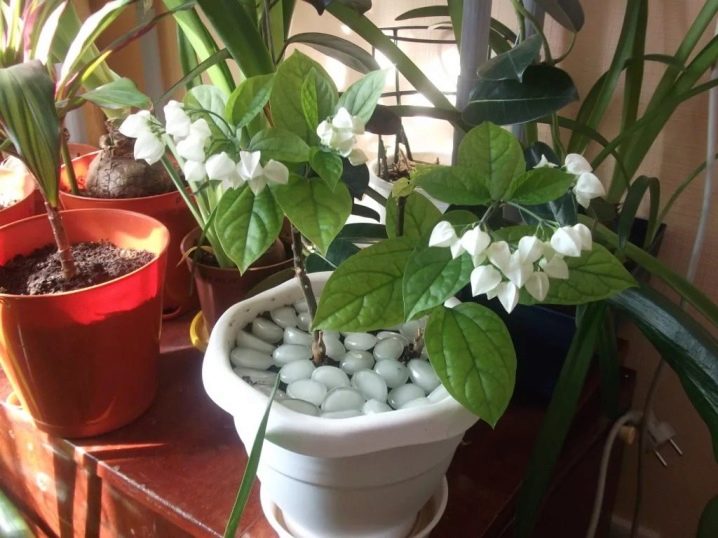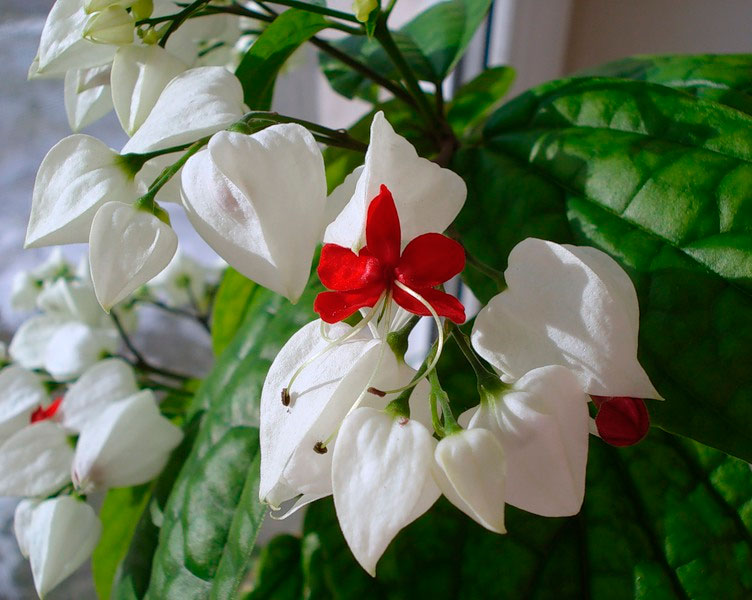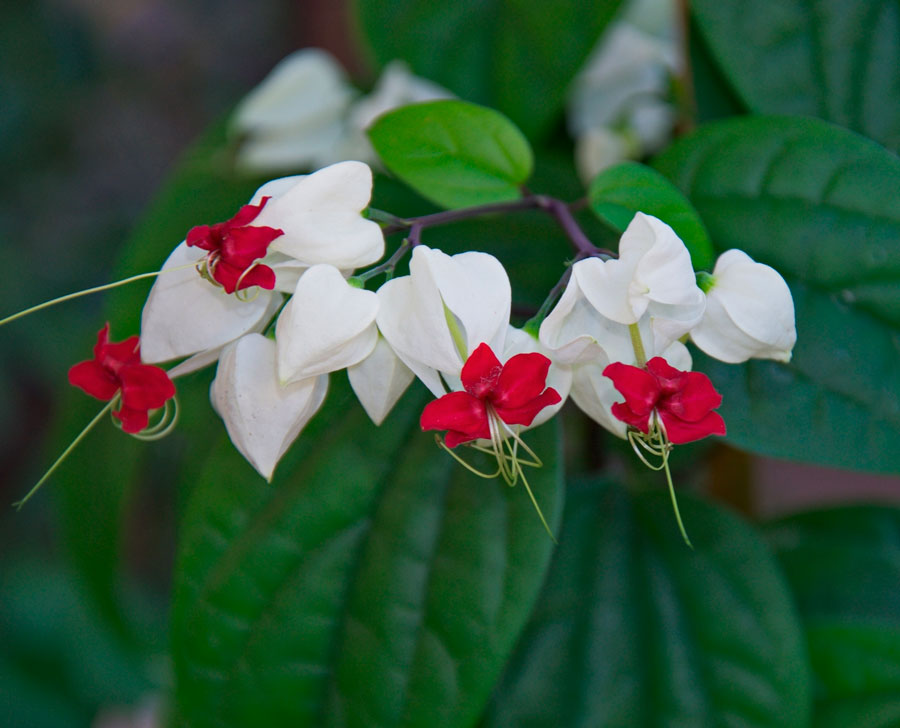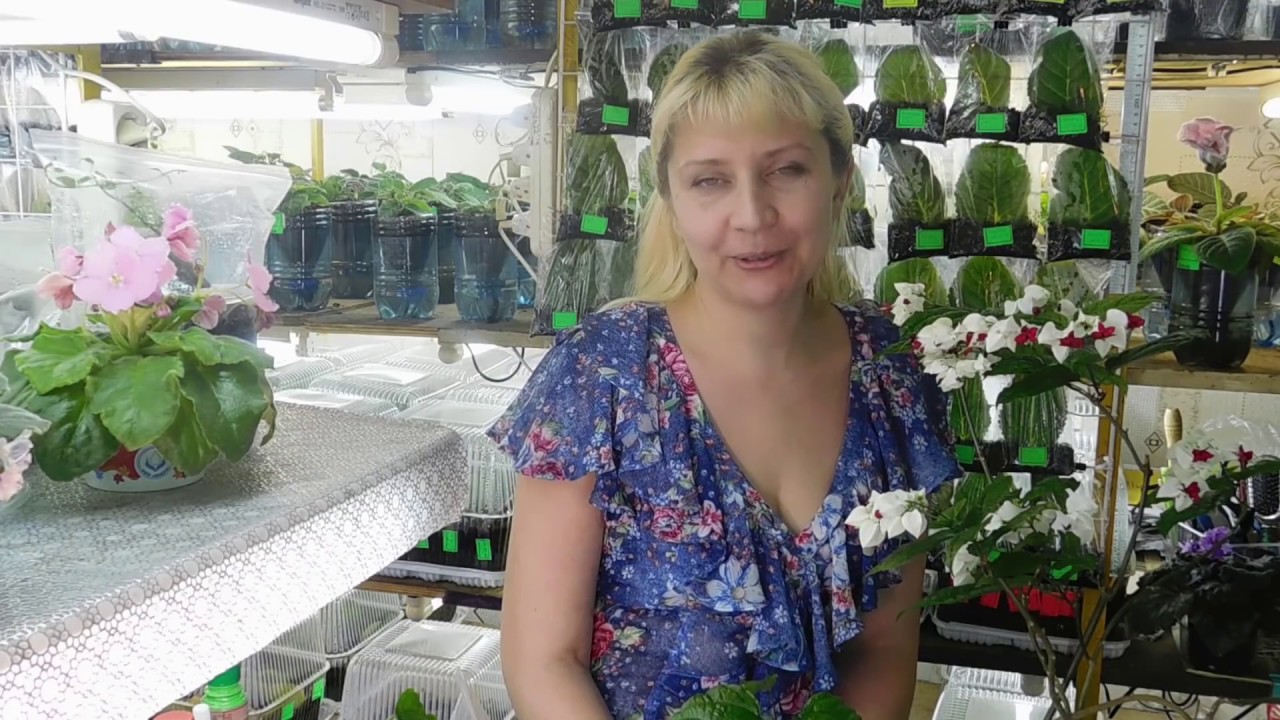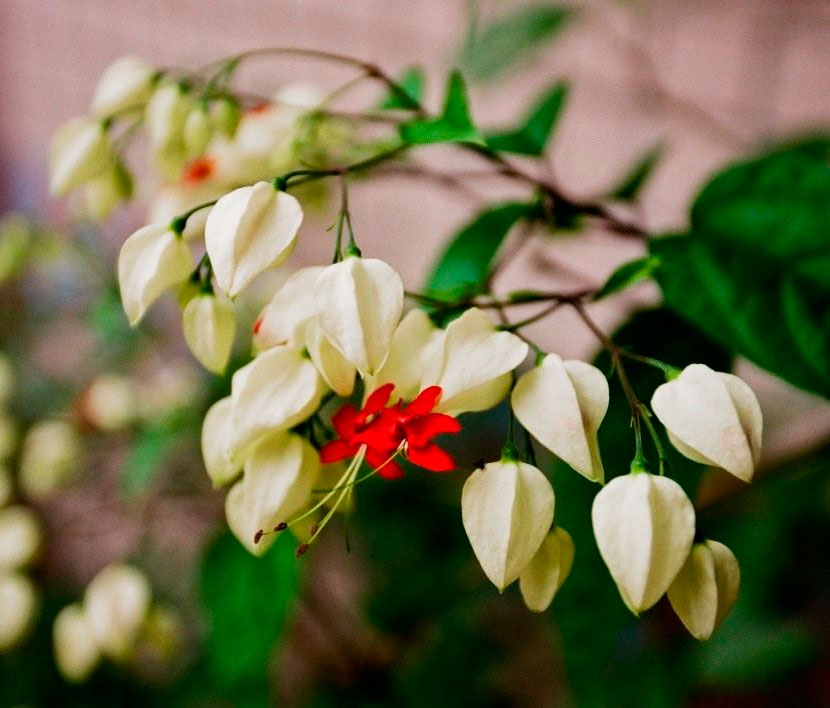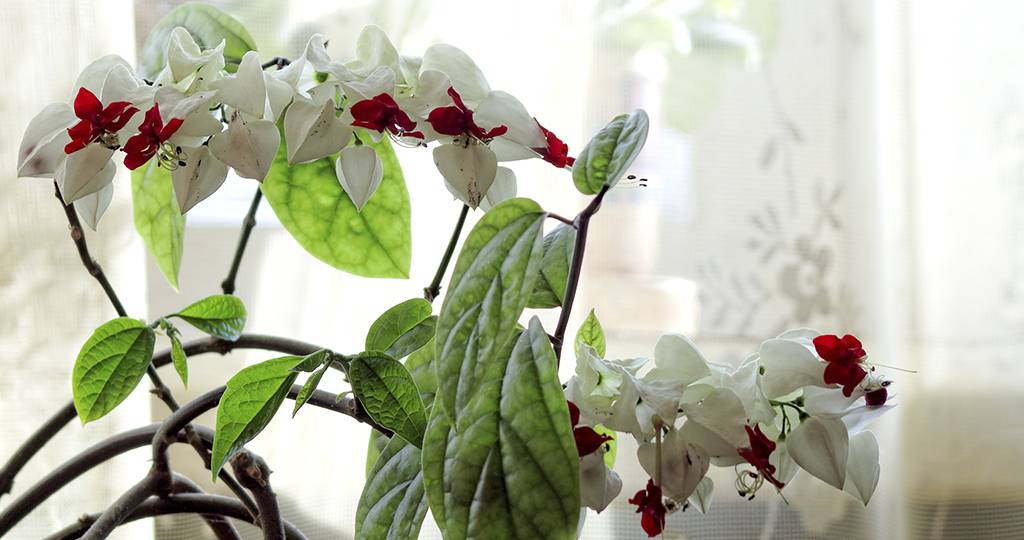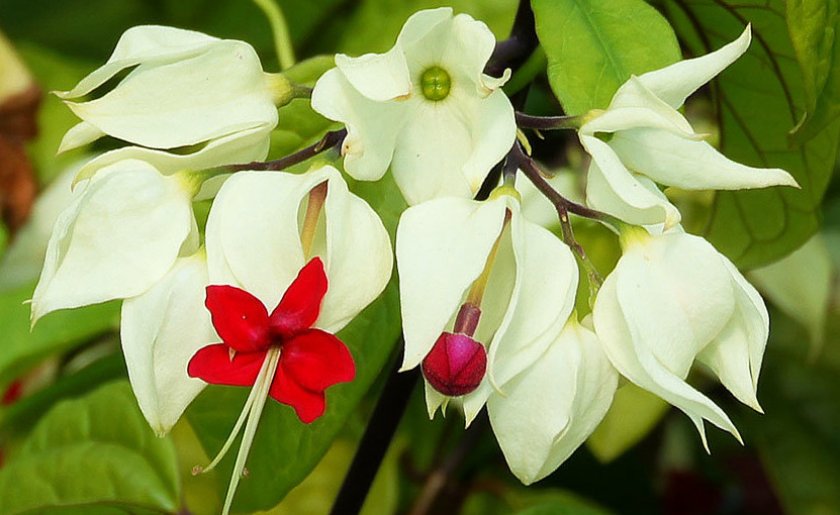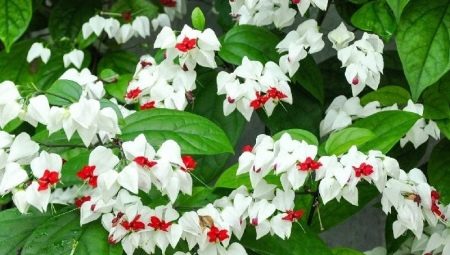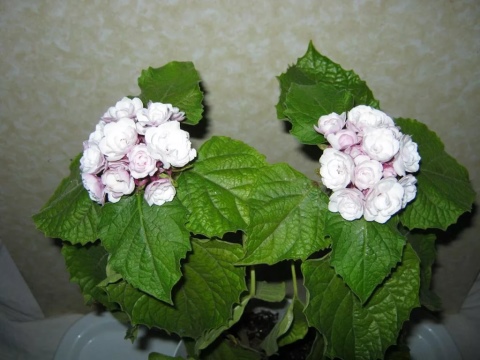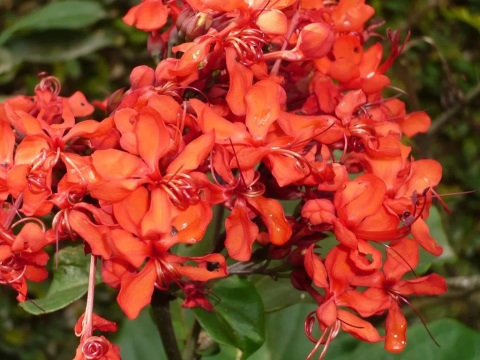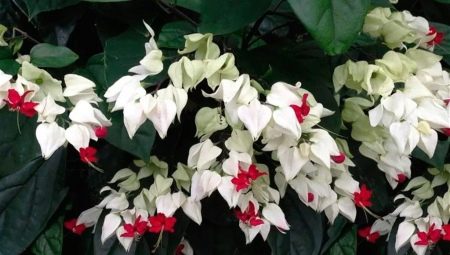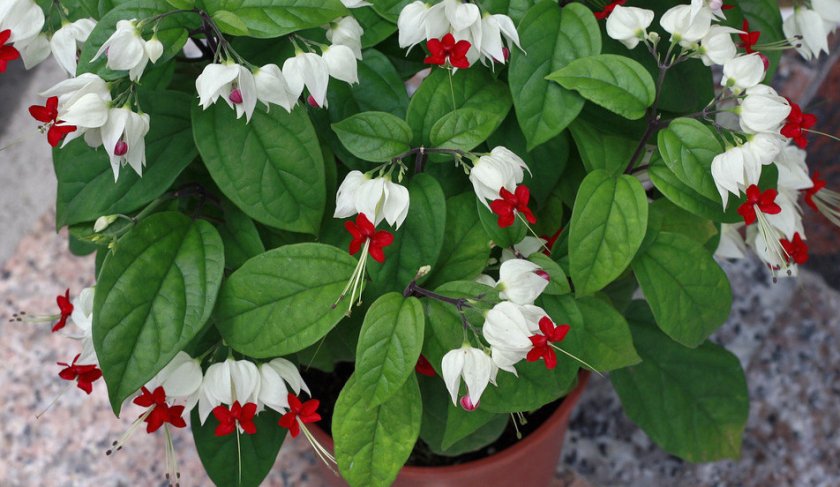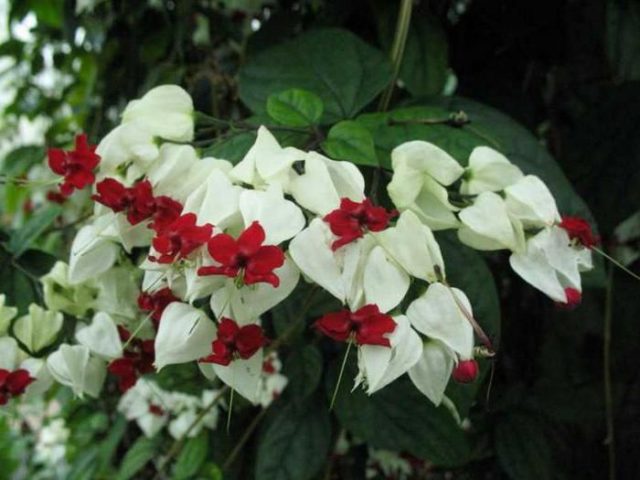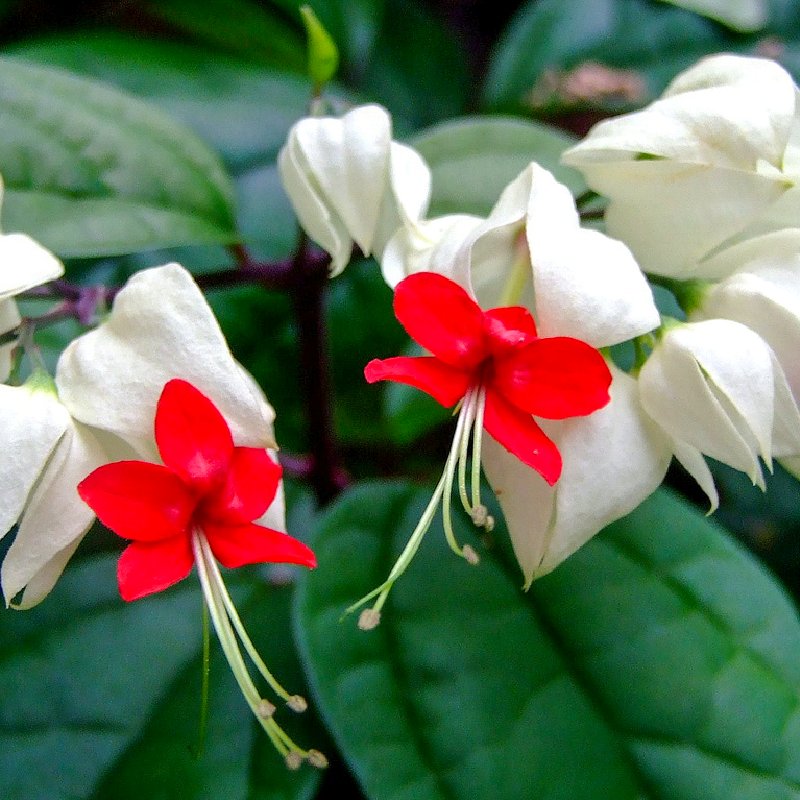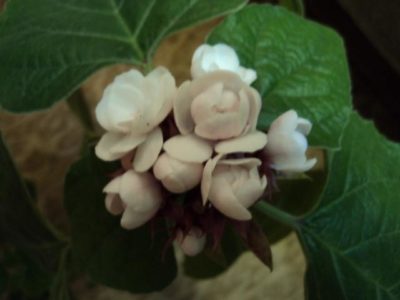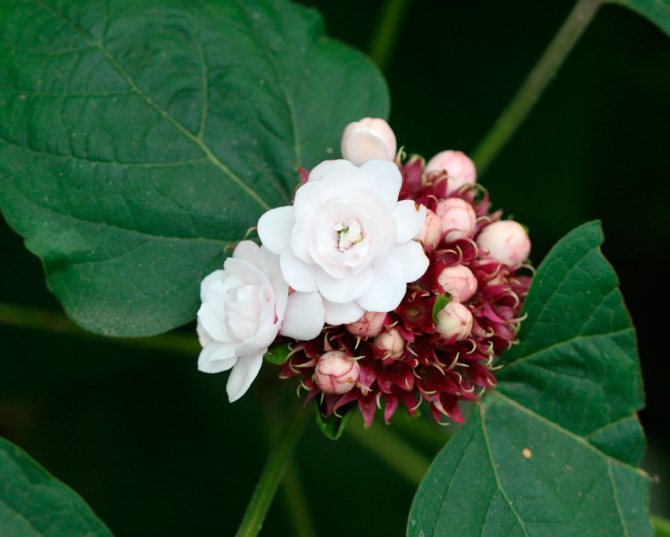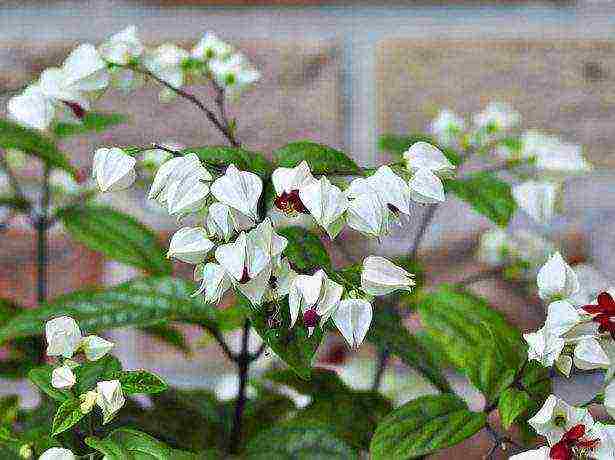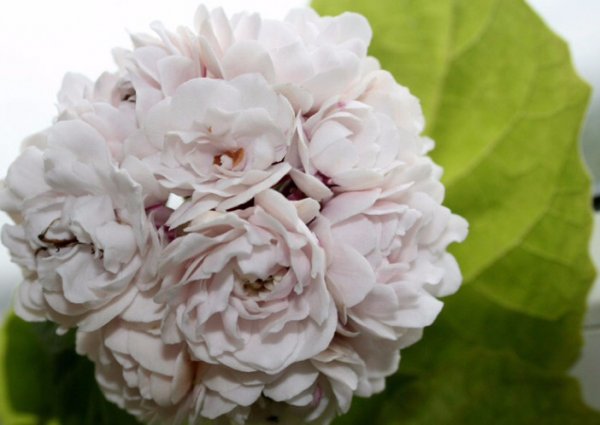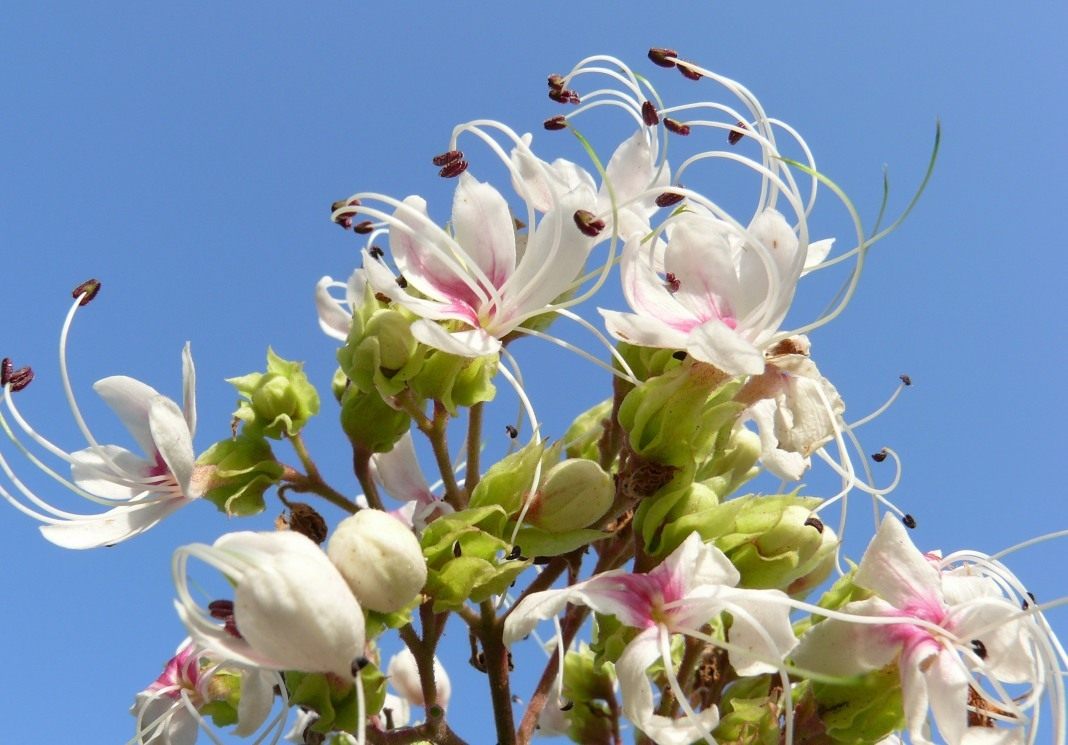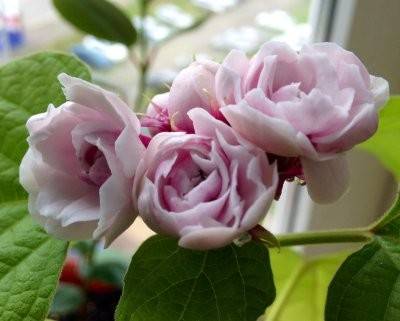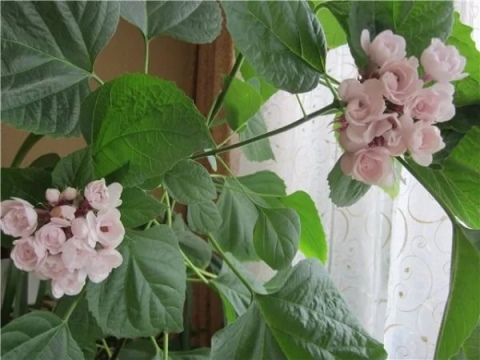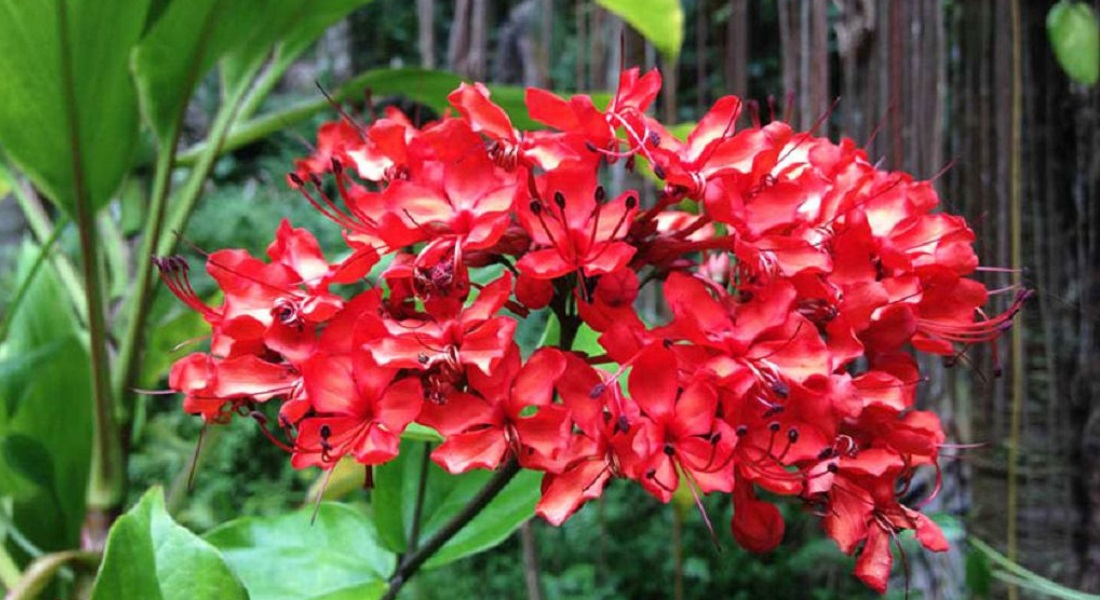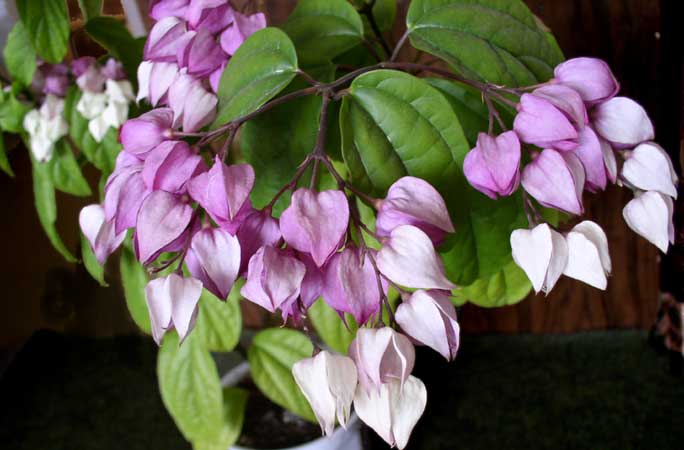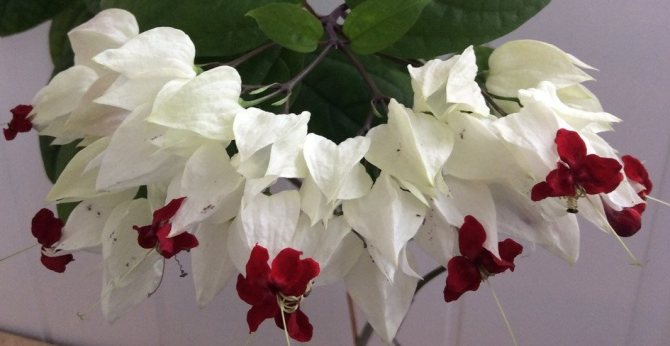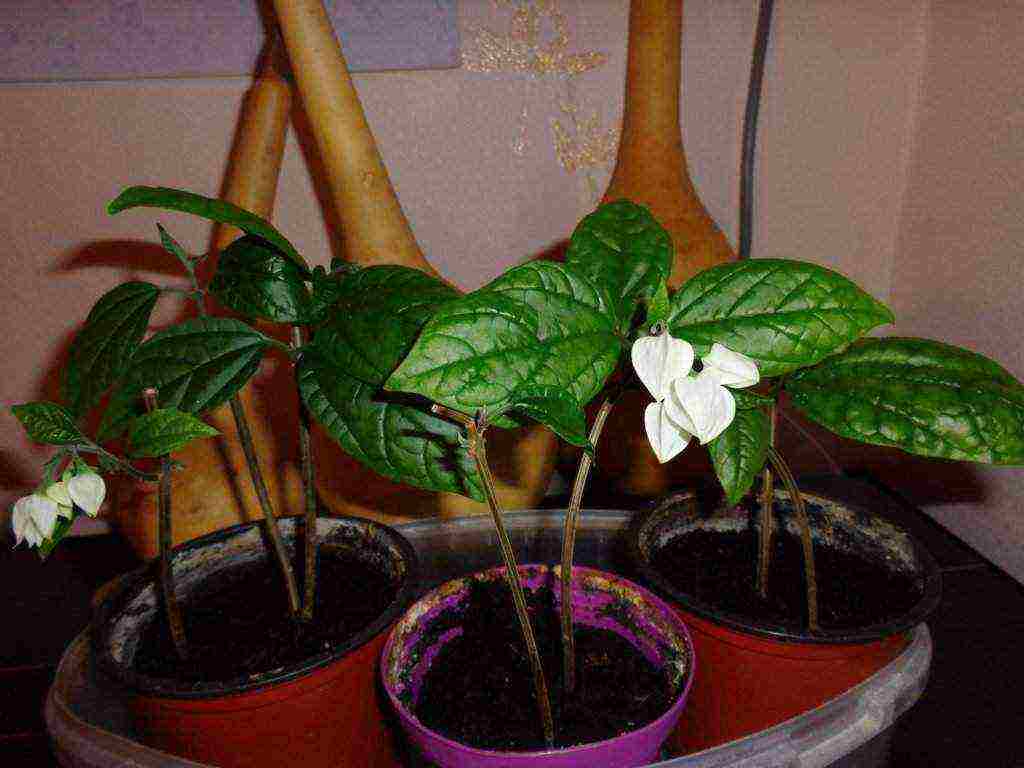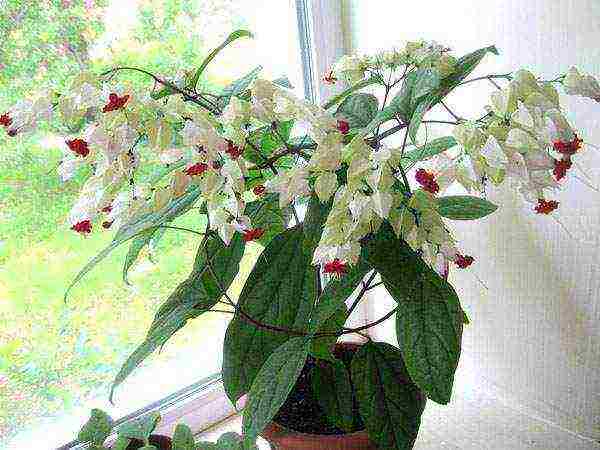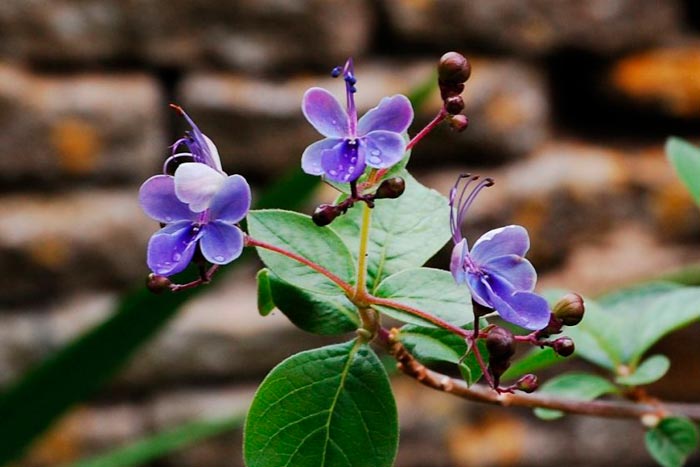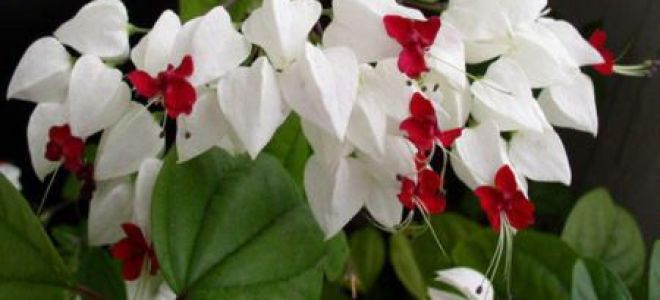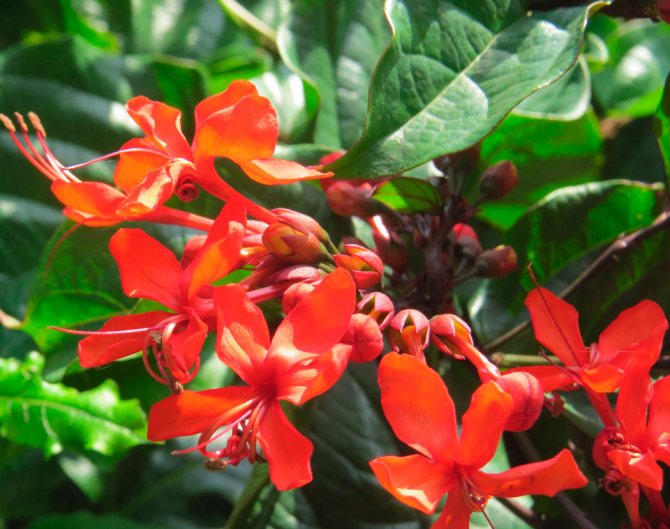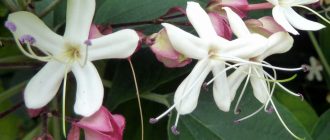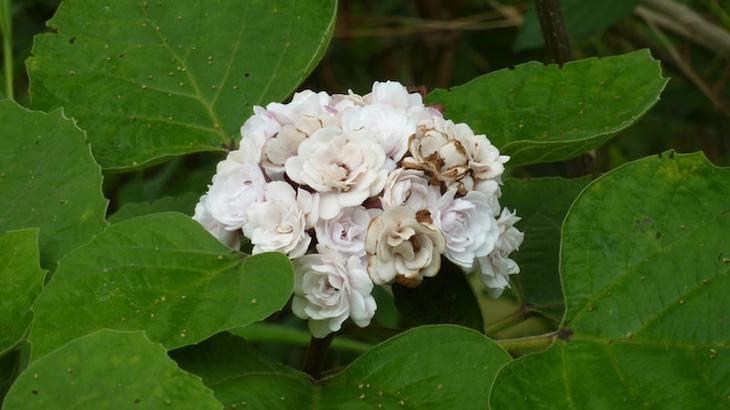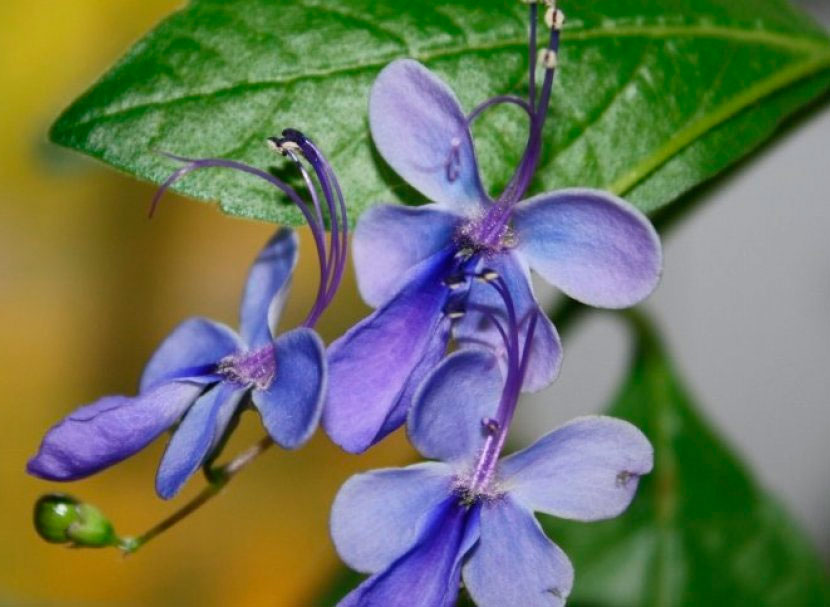Caring for clerodendrum at home
How to care for clerodendrum
For healthy growth and full flowering, a tropical forest plant needs conditions that are as close to natural as possible. Clerodendrum at home prefers sills of windows facing south, west or east - it needs bright light, but with protection from direct sunlight. The temperature in the summer period is optimal within 18-25 ºC, during the dormant period, which falls on the winter months, the plant needs coolness - no higher than 15 ºC.
The air humidity in the room with the clerodendrum should be elevated, so you will have to sprinkle the plant every night with soft, settled water in the warm season, and in winter, remove the flower pot away from heating appliances.
Watering the clerodendrum should be abundant, with soft water, but between waterings, the topsoil should dry out. During the dormant period, the soil is moistened according to the following principle: the cooler it is in the room, the less often we water it, but the earthen lump should not dry out completely. From mid-spring to the end of summer, twice a month, the clerodendrum is fertilized with complex fertilizers for flowering indoor plants; in autumn and winter, additional fertilizing is not needed.
Flowering clerodendrum
The flowering of clerodendrum begins, depending on the species, from June, and these plants fade in September. It is interesting to observe how white bracts appear on the still bare shoots of Thompson's Clerodendrum in early spring, from which crimson corollas up to 2.5 cm in diameter are formed. Clerodendrum beautifully blooms from June to September with panicles of purple flowers, and fragrant clerodendrum blooms almost all year round. Anyone who has seen the flowering of clerodendrum will definitely want to see this magic again.
Pruning clerodendrum
Caring for clerodendrum involves the obligatory annual pruning of the plant at the beginning of the period of active growth. Caring for Thompson's clerodendrum, for example, in addition to removing dried or weak branches, requires shortening all shoots by a third of the length, which should stimulate abundant flowering, as well as intensive growth and branching of young lateral shoots, on which inflorescences are formed. The clerodendrum is pruned and in order to form the crown - if you want the clerodendrum to grow as a bush, you need to greatly shorten the shoots during spring pruning, otherwise you will have to install a support for them later.
How to prune a clerodendrum to make a tree? The stamp form is created as follows: all shoots are removed, except for one, the strongest, which is cut off at a height of 50-70 cm, and then all shoots appearing in the top area are pinched in order to create a crown due to their branching. If sprouts appear on the stem below the crown, they are removed.
Clerodendrum transplant
Growing a clerodendrum requires replacing the old soil with a new one from time to time, in addition, an overgrown plant may require a larger pot. Plants are transplanted at the beginning of active growth after pruning. Young plants need an annual transplant, and for those that are older, it is enough to change the soil and pot once every two to three years. The soil for clerodendrum should be nutritious and slightly acidic (pH 5-6). You can use the soil purchased in the store, adding sand to it, or make it yourself from peat, coarse sand, sheet and clay soil in equal parts.
Before replanting the plant, the new soil must be disinfected by steam, in the oven or microwave.How to transplant clerodendrum? Take a pot 2 cm in height and 2 cm in diameter larger than the old one, put a layer of drainage three centimeters high in it and transfer the plant from the old flowerpot to a new one, being careful not to damage the root ball. Add the required amount of new substrate to fill the voids in the pot and water the plant. If your clerodendrum needs support in the future, dig it in during transplanting so that later you do not have to stick it into the pot, damaging the roots of the plant.
Types of clerodendrum
In total, more than 300 varieties are registered in the genus, but not so many are used in indoor floriculture.
Clerodendrum of Mrs. Thompson (Thompson). The most popular type is the deciduous ligneous vine with thin, smooth shoots. Dense dark green foliage grows up to 12 cm in length. The leaf plate swollen between the veins has an oval shape with a pointed end. In March-June, loose clusters on long peduncles rise above the vegetation. White, bell-like bracts surround small scarlet buds. Long white or creamy stamens peep out from the center. Outwardly, the flower is very similar to a moth with long antennae.
Mrs. Thompson's Clerodendrum
Clerodendrum Ugandan. The evergreen vine grows shoots up to 2 m in length. They are covered with broad-lanceolate dark green leaves, between which loose panicles with bluish-purple small flowers grow. The stamens on these flowers are especially long and blue in color. The lower petal is enlarged, it has a darker shade. The variety requires brighter lighting and abundant watering.
Clerodendrum Ugandan
Clerodendrum is brilliant. An evergreen shrub with long, curly stems. Leaves on it grow oppositely or in whorls of 3 pieces. The almost rounded leaf plate reaches 8 cm in length and 6 cm in width. The edges of the leaf are wavy, the base resembles a heart. From the axils of the foliage, short peduncles with dense brushes of scarlet-red buds grow. In favorable conditions, it blooms all year round.
Clerodendrum brilliant
Wallich's Clerodendrum (Prospero). On long flexible branches of a reddish-green hue, large dark green oval leaves grow. Their length is 5-8 cm. Large inflorescences with snow-white flowers bloom between them. The bush itself is quite compact, but capricious. He needs long daylight hours and high humidity.
Wallich's Clerodendrum
Clerodendrum Filipino. The variety, which is still rare for our country, is distinguished by an intense aroma of flowers, in which notes of vanilla and jasmine are mixed. In the evening, the smell intensifies. A dense corymbose inflorescence blooms on a long peduncle. The buds look like tiny (up to 3 cm in diameter) roses. The width of one inflorescence reaches 20 cm, so it really resembles a bouquet. Shoots are covered with wide-oval dark green velvety leaves. Flowering begins from the second year of life.
Clerodendrum Filipino
Clerodendrum bunge. The Chinese species grows especially rapidly. The plant grows light green broad-oval leaves, which are collected in whorls. Beautiful spherical inflorescences of small pink buds bloom on the stems. From a distance, the flower looks like fireworks. Flowering continues throughout the summer.
Clerodendrum bunge
Clerodendrum specialosum (finest). A spreading bush up to 3 m high consists of branched tetrahedral shoots. This evergreen plant is covered with large, heart-shaped leaves with short soft hair. They grow on reddish petioles. From June to September, purple inflorescences with a darker, lilac-red corolla delight.
Clerodendrum specialozum
Clerodendrum inerme (unarmed). An evergreen shrub with long vines covered with oval emerald leaves with a prominent central vein. It blooms with white, moth-like flowers with long purple stamens.An interesting variety inerme variegated. It is distinguished by lighter (light green) spots on the leaves, which create an exquisite marble pattern.
Clerodendrum inerme
Clerodendrum Schmidt. A shrub or small tree is distinguished by dense shoots and bright green oval leaves with a wavy edge. During the flowering period, many brushes are formed on drooping peduncles. They carry snow-white flowers. They exude a pleasant sweetish aroma.
Clerodendrum Schmidt
Reproduction
There are two ways to propagate a plant:
By cuttings
It is considered the easiest way. This breeding option is carried out in the spring. The apical part of the stem with 3-4 internodes is cut from the main bush.
For rooting, planting material is left in a glass of water or in a special substrate. To speed up the process, the plant can be covered with transparent polyethylene. The temperature regime should be kept above twenty degrees Celsius.
Seeds
This method is a little more complicated than the previous one, but no less effective. Seeds are planted in February - March in containers with a substrate and covered with foil. In this way, greenhouse conditions are created.
In order to avoid stagnation of moisture, the seeds must be watered and ventilated periodically. Also, the seedlings should have good lighting.
Two months later, the first sunrises will appear, and when four leaves grow on them, they are transplanted into small containers. After good rooting, the seedlings are moved into larger pots and accustomed to new conditions.
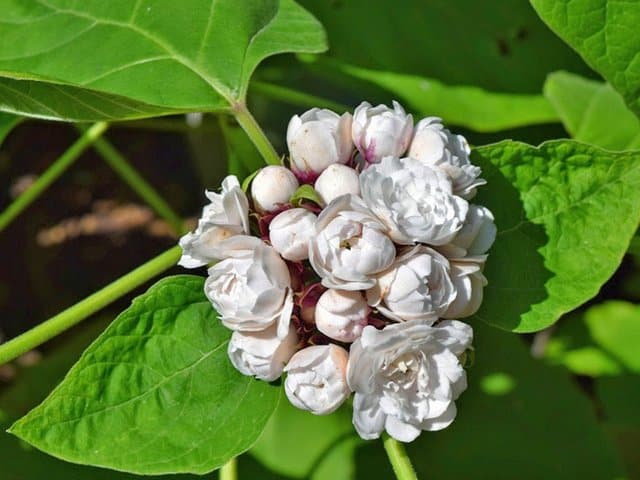
Description
Clerodendrum (lat.Clerodendrum) is a liana-like or shrub plant, characterized by lush and long flowering. Translated from the ancient Greek, the word "clerodendrum" is translated as "the tree of fate", and the whole history of the species is shrouded in many beliefs and legends. For example, the aborigines of the island of Java believed that a donated branch of a plant could drastically change a person's fate, giving him some important chance.
Among the ancient Romans, volcameria was considered a love amulet and was presented as gifts to the goddess Venus, being the main decoration of her temples. In European countries, the peak of popularity of clerodendrum came in the middle of the 19th century, when the plant began to be actively grown in greenhouses and flower gardens. A little later, it became the object of close attention of breeders, who, by crossing different species, received a large number of the most beautiful varieties.
Clerodendrum is a member of the Lamiaceae family and is found in the natural environment in the tropical regions of Asia, Africa and Latin America, as well as on the islands of the Indian Ocean and Australia. Among a wide variety of species, there are both evergreen and deciduous forms, while vines can reach 4 m, and shrub representatives of the genus grow to only two. The tetrahedral stems of the plants have a smooth olive or red-brown skin and are covered with opposite petiole leaves of a bright emerald color. The shape of the leaf blades depends on the plant variety and can be heart-shaped, oval or ovoid. The length of the leaves varies from 8 to 20 cm, and the edges can have a solid or finely toothed structure. The surface of the blades has a distinct venation with a well-visible depression along the central and lateral veins.
8photos
The inflorescences of the clerodendrum consist of small and very beautiful flowers, located in the tops of the shoots or axils of the leaves and have a corymb or paniculate type of structure. Thanks to long peduncles, they look very elegant and look like lush bouquets. The cups are bell-shaped and divided into 5 lobes, and their diameter can reach 2.5 cm. The corolla is painted in contrasting colors, and long and thin stamens grow from its middle, often reaching 3 centimeters.
The flowering period for most volcameria lasts from April to September and is accompanied by a very pleasant aroma.Moreover, not only flowers smell, but also leaves, while each species has its own unique smell. The bracts of the clerodendrum are large enough and remain on the bush until dormant, causing the impression of constant flowering among others. After flowering, most plants produce orange fruits that are oblong, 1 cm long and contain a single seed.
Types and varieties of clerodendrum: photos and description of varieties
There are more than 300 species in the clerodendrum genus. Many of them are characterized as rich and long flowering plants. Some of their varieties are used as horticultural crops in countries with warm climates. For example, K. fragrant (C. fragrans) with double, red-purple flowers. Has a sweetish aroma with a touch of citrus.
But for countries in a temperate climatic zone, breeders have bred varieties of this vine that can be used as a houseplant. Although there are not so many domesticated type clerodendrum, there are species and their varieties that you can talk about:
Clerodendrum Thomsona (S. thomsonae).
Clerodendrum brilliant (C. splendens).
Clerodendrum Inerme variegatny grade.
Clerodendrum Bunge (C. bungei).
Beautiful clerodendrum (C. speciosum).
Clerodendrum false (C. fallax).
Clerodendrum Ugandan (C. ugandense).
Clerodendrum Filipino (C. philippinum).
Look below at some of the clerodendrum of domesticated species and some of their varieties in the photo, check out a more detailed description of each of them:
Thomson's clerodendrum (C. thomsonae) with scarlet flowers and a white calyx are widespread. Leaves up to 20 cm long, entire, dark green, stems reach a height of 3 m. Each bud is up to 2.5 cm in size, with a bell-shaped swollen white or cream cup, at the end of which scarlet stars "glow". Small flowers gather in paniculate inflorescences. This is how the most common type of indoor floriculture looks like - Thompson's clerodendrum.
Look at the Clerodendrum of the Thompson variety in the photo:
The first buds can be seen already in March, and again the vine can give color in autumn. After the corolla withers, the cups remain on the plant for a long time, but at the same time its shade becomes lilac.
Klerodendrum brilliant - a type of evergreen shrub, characterized by round, curly shoots. The shape of the leaves is round, heart-shaped, up to 8 cm long, up to 6 cm wide, the edges are wavy. Brilliant Clerodendrum is one of the few species of this plant that has a very long flowering period, it can last almost all year. At this time, shield-like short inflorescences with red buds will appear on the liana, which will gradually replace each other.
Clerodendrum of the Inerme species is distinguished by oval foliage of an emerald hue. The inflorescences are similar to moths with long stamens of a purple hue. In Clerodendrum Inerme, Variegatny foliage is distinguished by the presence of lighter spots, which makes the color of the greenery similar to marble.
Clerodendrum Bunge is a fast-growing liana, from which, by cutting off shoots, you can easily form a plant in the form of a medium-sized bush. It has heart-like leaves, dark green in color. A characteristic feature of this domesticated flower is that when exposed to direct sunlight, its foliage becomes a lilac hue. And if the plant does not have enough light, then it falls off.
Clerodendrum of this variety blooms with crimson buds that appear at the ends of the shoots. But as the flowers develop, they change their color, acquiring a pale pink hue in a blossoming state. The inflorescences are large enough, spherical and look like fireworks.
The beautiful clerodendrum is an evergreen shrub with characteristic shoots that have 4 edges.The leaves are cordate and slightly rounded, the edge of which is wavy. The most beautiful inflorescences of this species, which gather in apical panicles, have purple cups with dark red corollas on them. The first buds can be seen in June, the flowering period ends by September.
Look at other varieties of the clerodendrum flower in the photo and appreciate their decorative effect:
Despite all its beauty, this plant is not too whimsical to care for and grow, but still requires some attention.
Pruning when forming the crown of the clerodendrum at home
When transplanting, you can combine this process with pruning flower shoots. Remove long and weak processes, and pinch them to give the plant a more lush shape
The formation of the crown of a clerodendrum is very important, since this flower belongs to vines, then its size can reach 2-3 meters, which is not always appropriate in an apartment. And only regular pruning will help to maintain the shape of an ornamental bush or tree.
The simplest pruning of a plant is to remove 1/3 of the length of woody shoots. This annual clipping of the clerodendrum promotes abundant flowering.
When grown at home, this liana is usually given the shape of a medium-sized bush. To do this, at the beginning of spring, all shoots are cut to a size of 7 cm from the point of growth. Then the plant begins to grow actively, new young shoots with leaves appear and the result is a nice flowering bush.
Difficulties in growing
Clerodendrum Filipino is not susceptible to a large number of diseases and pests that a houseplant can suffer from, but in the process of growing it can be attacked by:
- spider mite;
- shield.
To eliminate these ailments, it is necessary to carry out the following procedures:
- wash the plant under a hot shower. The water temperature should be around +45. + 50 ° С;
- treat the flower with chemicals with insecticides.
Changes in the appearance of the plant can occur as a result of improper care:
- The lack of flowering can occur due to improper wintering of the clerodendrum. For him, it is necessary to arrange a rest from flowering, reducing watering to a minimum in winter and transferring the flower to a room with a temperature of +12. + 15 ° С for 1–1.5 months.
- The lack of new buds in spring can occur due to the lack of proper lighting in sufficient quantities.
- Also, the flower may not bloom due to the fact that it lacks nutrition from the substrate in which it grows. Accordingly, Filipino Clerodendrum must be transplanted into a new suitable soil.
- Root rot can cause flower death. This phenomenon is possible with too abundant watering and insufficient drying of the soil. To save the plant, it must be transplanted into a new container, removing the damaged areas of the rhizome.
- The yellowing of the leaves and their leaf fall are the reason for the lack of watering.
Clerodendrum - a flower for a good mood
Interestingly, as an indoor flower, clerodendrum began to grow relatively recently, having acquired the well-deserved love of flower growers
Room designers have also paid attention to this touching and delicate plant. It looks great in winter gardens and interiors with a touch of romance
They say that the contemplation of its flowers not only brings aesthetic pleasure, but also gives thoughts a positive attitude, relieves stress and excessive irritability. I confirm!
The plant has several popular names, for example, "innocent love" or "volcameria". At first it seemed strange to me that the nickname “tree of fate” was considered the main one, although in terms of structure my clerodendrum is a pronounced liana. She needs support and space, then flexible branches with dark green embossed leaves can stretch up to 3 meters.
I have Thompson's clerodendrum (Clerodendrum thomsoniae) growing, and some of my acquaintances have got used to the Filipino.Interested, I learned that there are still tall species that fully justify the word "tree" in the name:
- the most beautiful;
- fragrant;
- Ugandan.
All types of clerodendrum have a subtle pleasant aroma with a unique hue, which is attributed to antidepressant properties.
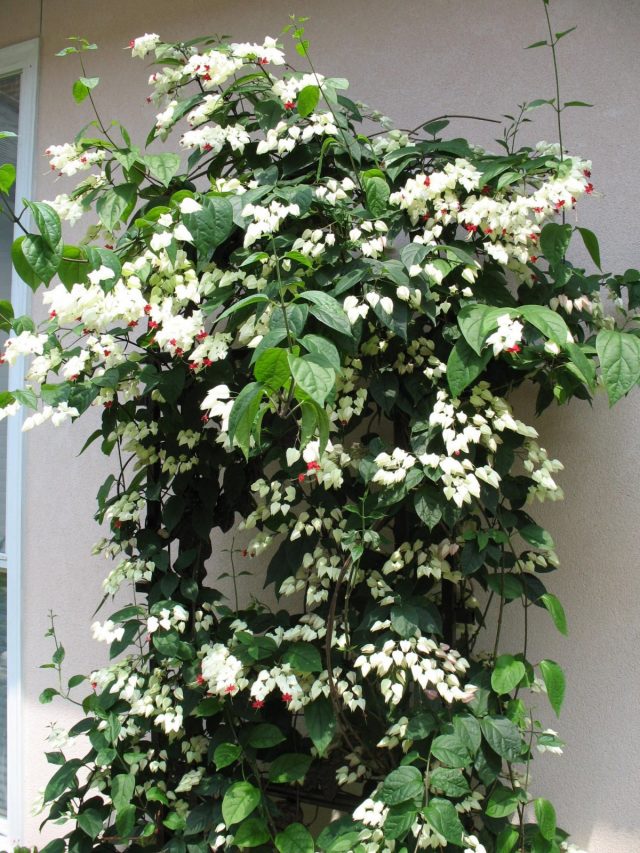 Clerodendrum has several popular names, for example, "innocent love" or "volcameria". onlineplantguide
Clerodendrum has several popular names, for example, "innocent love" or "volcameria". onlineplantguide
Diseases and pests
Clerodendrum has excellent immunity and rarely gets sick. Therefore, developmental abnormalities are more often due to mistakes in care than infectious diseases. Below is an overview of the most common problems, as well as possible causes and solutions.
- If the leaves of Clerodendrum turn yellow and wither, then the matter is most likely in insufficient watering. In this case, it is recommended to carefully trim the yellowed foliage and put the plant on a regular moisturizing regime.
- If the leaves, along with the buds, dry and fall off, then the reason may lie in the excessive dryness of the room air. To eliminate it, it is recommended to use moisturizers and spray the plant more often.
- If the leaf blades are covered with brown spots, it is most likely a sunburn. In this case, it is necessary either to shade the plant, or to create diffused light for it. This can be done using gauze stretched over the window or a tulle curtain.
- A large distance between two adjacent internodes and a bare stem are often the result of insufficient lighting. In such cases, it is recommended to place the plant closer to the sun or arrange additional lighting with a phytolamp.
- A long absence of flowering is often caused by improper organization of the dormant period or unbalanced feeding. Transplanting it into a fresh substrate and compulsory sleep during wintering will help to make the plant bloom. To do this, from the second half of October, the flower is transferred to a cooler room and watering is reduced. Some species completely shed their foliage at this time, which should not cause concern: after winter rest and spring pruning, the plant will quickly grow green mass and become even more beautiful.
- Chlorosis, the main signs of which are a decrease in color intensity, the appearance of yellowness and a change in the shape of leaf plates, is often the result of a lack of one or another trace element in the soil. The disease is not fatal and can be well cured by applying a complex of mineral fertilizers.
- Powdery mildew is often the result of watering with very cold water, so only liquid warmed up to room temperature should be used for humidification.
As for pests, the most common attack on clerodendrum is whitefly, scale insects and spider mites. The reason contributing to their appearance is too dry indoor air. You can completely get rid of insects with the help of modern insecticides. Processing is recommended to be carried out in two or three passes, taking a week break between them.
If it is not possible to purchase special drugs, then you can try folk methods. To do this, the clerodendrum is watered with infusion of onions or garlic. Most pests do not tolerate their specific odor and leave.
For information on how to grow clerodendrum, see the video below.
Views

The genus Clerodendrum combines many species and varieties.
But not all of them are suitable for breeding at home. The most popular are three types.
Clerodendrum thomsoniae

Clerodendrum thomsoniae
Clerodendrum thomsoniae
It is also called Mrs. Thompson's clerodendrum. The variety looks like a liana with smooth thin stems. The sheets are dark green, with clear veins and smooth edges, up to 12 cm long.
There are blotches of darker or lighter shades on the leaf plate. Snow-white flowers with a scarlet corolla form small tassels, bloom from early spring to June.
The plant quickly grows in size in an apartment and rarely complains of well-being.
Clerodendrum splendens
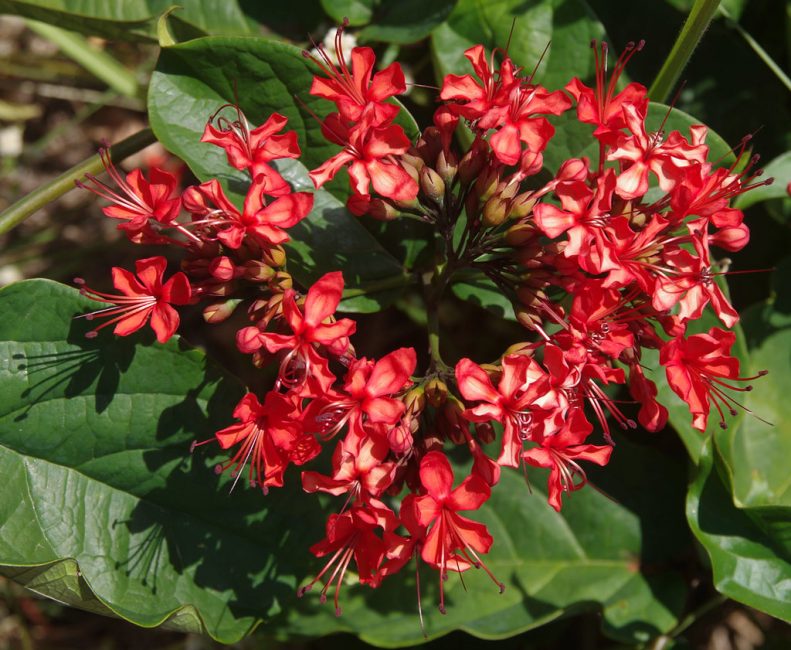
Clerodendrum splendens
Clerodendrum splendens
The variety is presented in the form of a bush with curly stems. The sheets are almost round, with a pointed tip and a wavy edge. In length - up to 8 cm.
Axillary inflorescences form red brushes. Flowering lasts almost all year round.
Clerodendrum philippinum

Clerodendrum philippinum
Clerodendrum philippinum
Another variety with an unpretentious character. Philippine clerodendrum is one of the most fragrant: the aroma of the plant combines notes of vanilla and jasmine. The smell is especially noticeable in the evenings. The leaves of the plant are dark green, and the flowers are white with a pinkish tint, the inflorescences are large.
Also among the popular varieties include:
- Ugandan Clerodendrum, or Blue Butterflies (Clerodendrum ugandense)
- Wallich's Clerodendrum (Prospero) (Clerodendrum wallichii)
- Fragrant Clerodendrum (Clerodendrum fragrans)
- Clerodendrum Bungei
- Clerodendrum schmidtii
- Clerodendrum speciosissimum
- Clerodendrum Paniculatum
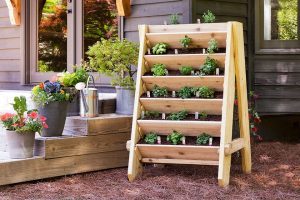
We make vertical beds with our own hands: the best ideas of 2018. For vegetables, berries, herbs and flowers (65+ Photos & Videos) + Reviews
Features of planting and care
The flower growers' comments on the nature of the flower are positive: caring for it is simple
Clerodendrum grows in the tropics and subtropics - in humid and warm climates. Therefore, it is desirable to provide similar conditions at home for its comfortable growth.
Temperature
For the catharanthus, the temperature will be 25 degrees in summer and 15 degrees in winter.
A tropical plant prefers warmth, especially during the growing season, when it is actively developing or blooming. It should be grown at an air temperature of + 20-25 ° С.
And in winter, the flower should rest, so the temperature should not exceed +15 degrees. Only in this case will there be a normal budding for future flowers.
Lighting
Growing on a windowsill
Clerodendrum loves the sun and bright, but diffused light. With a lack of lighting, it will begin to lose leaves.
It is better to protect the plant from direct sunlight.
This is especially important if you put the plant on the south window: the midday sun can leave burns on the leaves, damage delicate petals, and reduce flowering
It is better to choose an east or west window sill.
Optimum humidity
Flowering plant
Clerodendrum requires abundant watering, especially in summer. You should not water too often: you need to wait until the top layer of soil dries out in the flower pot.
In winter, watering is due to the indoor air temperature. If it was possible to lower it to the recommended levels, watering is rarely done, only so that the earthen lump does not dry out. If the temperature is slightly lower than it was during the growing season, watering is reduced only slightly.
A tropical guest loves humid air. It is necessary to spray the leaves and stems daily during the summer. It is better not to direct the streams of water from the spray bottle to the flowers. Water for irrigation and spraying must be soft and settled for at least a day.
In winter, the air in the room is strongly overdried by heating devices. Spraying in this case is not enough. Place wide bowls of water indoors or buy a humidifier.
Top dressing
Phosphate-potassium fertilizer
From spring to autumn, clerodendrum requires fertilization. They are fed on average once every 10-14 days. No additional feeding is needed in autumn and winter.
For clerodendrum, an alternation of mineral fertilizers with organic ones is suitable. Fertilizers for flowering houseplants are sold in flower shops.
Agricola is recommended as a mineral fertilizer; fertilize the plant according to the instructions. Organic fertilizing is also necessary to enrich the soil and improve its bioactivity. FlorHumate can be purchased. Top dressing is applied by spraying the foliage or directly into the soil so that they penetrate into the root system.
During flowering, clerodendrum needs an increased content of phosphorus.
Pay attention to the composition of the purchased funds
DIY Christmas tree toys: beautiful, original, with a soul! Master classes and step by step instructions | (75+ Photo Ideas & Videos)
How does it multiply
The flower propagates in two ways.
Seeds
To propagate the plant, you can use seeds taken from another home flower of the clerodendrum, or, if it is not available, you can buy it from a specialized store. The breeding procedure is complex and can be a hassle, and the resulting plant does not retain its species characteristics.
Seeds must be sown in a micro greenhouse in late winter - early spring. The first step is to fill the container with a mixture of turf, river sand and peat, then sow the seeds evenly over the surface of the earth.
Important! Crops need constant lighting. With proper care of the crops (timely watering and regular airing), the first shoots will appear in 1.5-2 months. After the formation of four full-fledged sheets, they should be seated in cups 6 cm in diameter
Up to three shoots can be planted in 11 cm pots
With proper care of the crops (timely watering and regular airing), the first shoots will appear in 1.5-2 months. After the formation of four full-fledged sheets, they should be seated in cups 6 cm in diameter. You can plant up to three sprouts in 11 cm pots.
Cuttings
When breeding clerodendrum with cuttings, it should be remembered that hardened and lignified shoots will germinate faster than green ones. The cuttings should be placed in water or moist soil, providing room temperature and good lighting. To prevent the twigs from drying out, they are covered with polyethylene. As soon as roots appear and new leaves grow, the plant can be replanted.
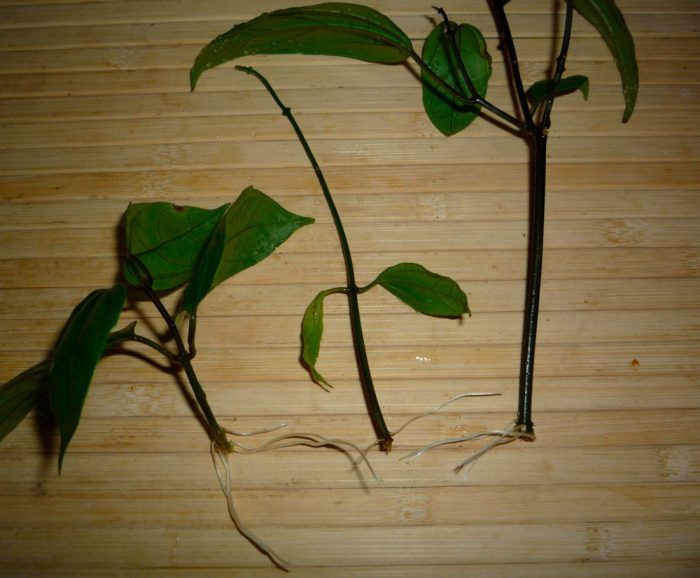
Clerodendrum cuttings
Landing
Before planting or transplanting a clerodendrum, it is necessary to prepare a nutrient soil. For this, leaf humus, clay soil, river sand and peat are mixed in equal proportions, or a ready-made substrate is purchased in the store. When preparing the mixture yourself, the main thing is not to "overdo it" with peat, since clerodendrum requires slightly acidic soil with a pH level of 5 to 6.5 units. The purchased soil has already passed the necessary processing and is completely ready for use, but the homemade composition must be well disinfected.
To do this, the mixture is cleaned of small mechanical debris and vegetation residues, after which it is spread in a thin layer on a baking sheet. Then the oven is heated to 200-220 degrees and the earth is placed in it for 20 minutes. If it is not possible to use the oven, then you can use the following method: pour a little water into the pan and stretch a soft, permeable cloth over it. Then a thin layer of substrate is poured over the material and the fire is turned on. After the water boils, the soil is left to disinfect for 10-15 minutes, then it is removed and a new portion is poured in its place.

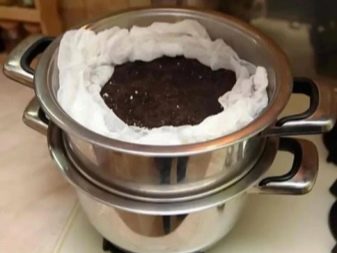
The transplant of adults is performed in the spring - as soon as the plant comes out of dormancy and prepares to actively build up the green mass. The procedure is carried out as needed, when the plant has grown strongly and there is a risk of the pot overturning. To do this, choose a large stable container, which is 2-4 cm wider than the previous one, form a drainage layer of expanded clay or river pebbles at the bottom with a thickness of at least 3-4 cm and pour a small layer of nutrient substrate.
Then the plant is transferred to a new pot using the transfer method, while preserving the integrity of the earthen lump as much as possible. The missing soil is poured along the edges and lightly tamped. The flower is placed in a calm, moderately shaded place, and after 2-3 days it is carefully moistened. Further, the clerodendrum is removed to its original place and transferred to a general care regimen.
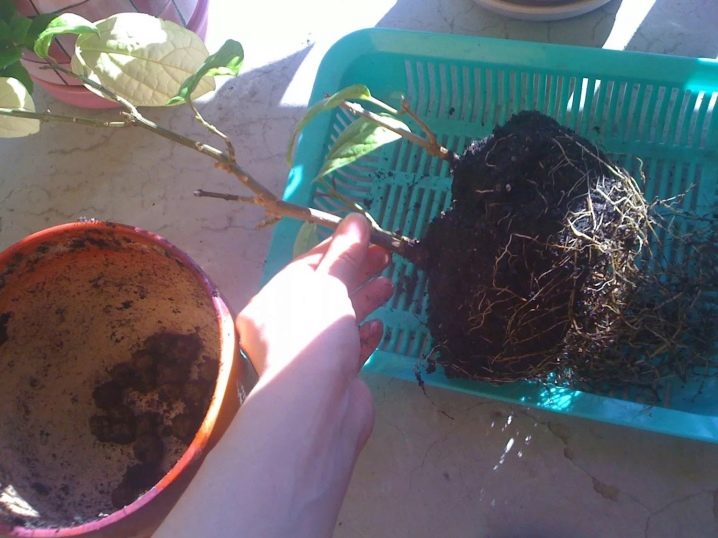
The transplant of newly purchased plants is performed at any time of the year.To do this, the plant is given 2-3 weeks to adapt to the new conditions of temperature and humidity, and only after that they begin to transplant it. To do this, slightly shake the pot and carefully separate the soil from its walls with a thin stick. Then the plant is transplanted together with an earthen lump, placed in the center of a new pot and the missing soil is added.
